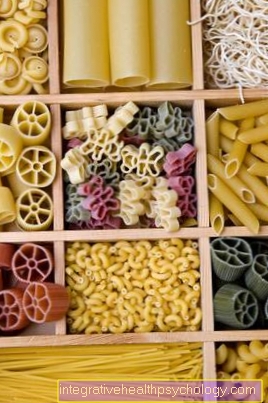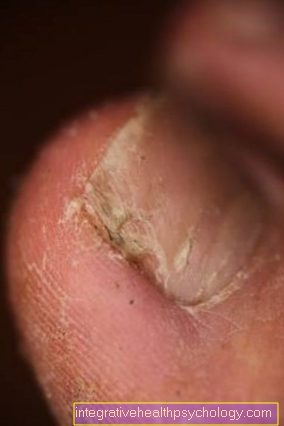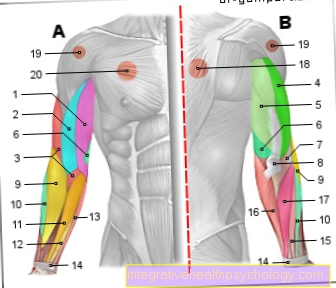Blood in the stool
introduction
If you discover blood in your stool, you shouldn't fear the worst.
Although the cause can also be malicious, harmless causes are much more common. A doctor should be examined in order to find the cause of the blood contamination.

causes
Some of the causes of blood in your stool include:
- Hemorrhoids and tears in the mucous membrane
- Stomach ulcers
- Diseases of the esophagus
- With diarrhea
- Taking antibiotics
- Bowel disease
- Vascular causes
You might also be interested in this topic: Colors of bowel movements
Hemorrhoids and tears in the mucous membrane
Hemorrhoids and anal tears are the two most common causes of bloody stools.
The most common cause of blood being found in the stool is hemorrhoids. In this case, the blood is very fresh, which can be seen both in the stool and often leaves its mark on the toilet paper.
Hemorrhoids are more common in people over 50 years of age. These are expanded vascular cushions that normally contribute to stool continence when they are not expanded. You are in a healthy state at the transition from the rectum to the anal canal.
If they are enlarged, however, they can also be visible from the outside. The increased pressure during bowel movements can tear them open and lead to fresh bleeding. Many factors can cause the hemorrhoids.
Often there is an accumulation in the family. An important risk factor is high pressure inside the abdomen and during bowel movements. This occurs, for example, when you sit for long periods of time, when you are very overweight, when you are constipated, or when you have a lot of straining during bowel movements, when you are on a low-fiber diet or when you are pregnant.
Small tears in the mucous membrane (fissures) in the area of the anus can arise in connection with constipation if the affected person has to press hard when defecating so that the mucous membrane cannot withstand the pressure in the long term.
Read more about this: Blood in the stool from hemorrhoids
Stomach ulcers
Are not uncommon bleeding stomach ulcers (Gastric ulcer) responsible for a tarry stool. A stomach ulcer develops in many people due to high alcohol- or Nicotine consumptionchronic stress or long-term use of pain relievers that attack the gastric mucosa. With these pain relievers, it is important to always take one at the same time Stomach protection like one Proton pump inhibitors to take.
Also one gastritis (Inflammation of the stomach lining) by the bacterium Helicobacter pylori can lead to a stomach ulcer.
An ulcer can develop not only in the stomach, but also in the following section, the Duodenum (Duodenum). However, blood in the stool can also be associated with inflammatory bowel disease, which are among them Crohn's disease and Ulcerative colitis. Both diseases manifest themselves primarily in phases of the Diarrhea. Especially with ulcerative colitis, these diarrhea can be bloody more often.
Diseases of the esophagus
An emergency with stool in the blood is bleeding from ruptured varicose veins in the esophagus, the so-called esophageal variceal bleeding. They can lead to life-threatening bleeding.
The varicose veins arise in connection with chronic liver diseases, in which the blood can no longer flow out via the liver, but has to look for alternative routes, including via the vessels of the esophagus.
Another disease of the esophagus is Mallory-Weiss syndrome. It occurs more frequently in alcoholics, in whom the mucous membrane is increasingly damaged. If vomiting then occurs, the pressure in the esophagus rises, which can lead to bleeding tears in the previously damaged mucous membrane.
Blood in the stool after diarrhea
The consistency of the stool is finely regulated through various processes within the intestinal mucosa. If diarrhea occurs, there is often a temporary problem with the intestinal lining. This represents the innermost wall of the intestine and can become inflamed by pathogens, certain foods, pollutants, stress and diseases of the body. The most common cause of a disease commonly known as "gastrointestinal inflammation" is bacterial pathogens that enter the intestine through food or through poor hygiene. As a result, the mucous membrane is no longer able to absorb the fluid from the stool and diarrhea occurs. Sometimes the inflammation of the mucous membrane can become so severe that minor injuries and tears in the mucous membrane occur, which are noticeable as blood in the stool.
The large amount of stool that passes through the intestines during the course of diarrhea can also lead to tears and small bleeding of the intestinal walls.
More on this topic under: Blood in the stool with diarrhea
Blood in stool after antibiotic
In rare cases, blood in your stool can be a side effect of antibiotic use. Especially if diarrhea is present at the same time, there is a likelihood of smaller amounts of blood in the stool. Inflammation of the gastrointestinal lining causes small cracks and damage in the intestinal wall, from which it can bleed. If the blood is excreted in the stool, it has already clotted and is therefore usually darker in color.
In rare cases, taking antibiotics can temporarily worsen the infection. This is the case, for example, when the bacterium releases toxins. When the antibiotics attack the bacteria, large amounts of the toxins are suddenly released, which can make the infection and blood in the stool worsen.
On the other hand, very long antibiotic use can promote intestinal infections. A relevant complication of long antibiotic use is Clostridium difficile infection, also known as pseudomembranous colitis.
You may also be interested in this topic: Side effects of antibiotics
Vascular causes
In elderly patients, the occlusion of an intestinal vessel, a mesenteric artery obstruction, can also trigger bleeding. Due to the occlusion of the blood vessel, part of the intestine cannot be supplied with oxygen and nutrients, which means that this part of the intestine dies in the long term, which in turn can lead to bleeding.
There are also changed blood vessels, a vascular inflammation (Vasculitis), as well as an increased tendency to bleed as a cause in questions.
You might also be interested in this topic: Bleeding disorder
Diseases in the intestine
In addition to the largely harmless causes of blood in the stool mentioned above, stomach cancer or colon cancer can also be the cause of bloody stools. Therefore, the attending physician asks during the clarification discussion about a family history of colon cancer, as in this case your own colon cancer risk is increased. Since colon cancer usually only occurs in people over 50, free colon cancer screening examinations are offered from the age of 50.
In addition to colon cancer, benign tissue growths called colon polyps can also cause blood in the stool. Evaginations of the intestinal wall - diverticula - can also trigger bleeding. Polyps and diverticula usually occur in the colon and in elderly patients.
Read more on the topic: How do you recognize colon cancer?
Can blood in stool be caused by stress?
Stress can have a significant impact on the body and its health. In addition to many cardiovascular diseases, stress can also affect the immune system and cause blood in the stool in a number of ways.
The so-called "stress ulcer" is very common. Excessive stress increases gastric acid production, which can lead to acid-related inflammation of the esophagus and stomach. An ulcer is very painful and can cause profuse bleeding from the lining, which can be seen as clotted, dark blood in the stool.
Stress also has an impact on the immune system and can weaken it, making stressed people more susceptible to infections. If there is a fever, diarrhea and blood in the stool, the primary suspicion is a gastrointestinal infection, which can be stress-related.
You may also be interested in this topic, as a stress ulcer is usually preceded by: heartburn
Other causes
Not to be forgotten too infectious causes. For example, salmonella, shigella, E.coli or parasites can trigger a gastrointestinal infection with bloody diarrhea and vomiting
In women, the disease also occurs Endometriosis as a trigger in question.
With this it comes to Carry-over of the lining of the uterus to other organs. The intestine is not the most typical place for this, but it can also be affected and lead to bleeding.
Blood in the stool during pregnancy
Haemorrhoids can occur more frequently during pregnancy, which are usually the cause of blood in the stool in pregnant women as well as in the rest of the population. In pregnant women, hemorrhoids occur primarily in the last third of pregnancy and in the first few weeks after the child is born. The increased occurrence of hemorrhoids during pregnancy can be explained by the changed hormone balance of a pregnant woman.
The hormones ensure that the tissue becomes soft and the blood vessels become wide in order to prepare the body for the coming birth. The effect is not absent in the rectum and thus increases the risk of developing hemorrhoids. Constipation is also more common during pregnancy. Around half of all pregnant women struggle with it. The hormones are also responsible for this, as well as the increased pressure of the uterus on the anus.
The constipation promotes the development of anal fissures (tears in the anal mucous membrane). In any case, a doctor should be consulted for clarification. Most of the time, however, there is nothing to be concerned about.
Read more on the subject at: Constipation During Pregnancy.
Blood in the stool without the occurrence of pain
Blood in the stool doesn't always have to be accompanied by pain. Infections as well as inflammatory bowel disease can develop painlessly.
The hemorrhoids, which in many cases are responsible for fresh blood deposits on the stool, also rarely hurt. If, in rare cases, colon cancer is behind the blood in the stool, pain is also a rare accompanying symptom. Colon cancer is known to cause pain rarely and in very late stages. The accompanying symptom of pain with blood in the stool therefore has little informative value about the type and prognosis of the underlying disease, which is why it is always advisable to consult a doctor.
Can blood in stool be indicative of colon cancer?
Colon cancer shows early symptoms only in very rare cases. The cancer often grows unnoticed and leads to pain, digestive problems, blood in the stool and numerous other symptoms very late.
However, typical of colon cancer is occasional bleeding on its surface due to the nature of the tumor and the rapid, diffuse growth of the cells. Permanent bleeding that persists for weeks and is not due to an infection or other bowel disease can be an important indicator of colon cancer.
For colorectal cancer screening, the so-called "Haemoccult test" is recommended and adopted every year in Germany from the age of 50. This can detect the smallest bleeding early on. Since the bleeding alone is not meaningful, a colonoscopy must be carried out afterwards in order to see a potential cancer and examine it more closely.
Also read our article: Signs of colon cancer
Accompanying symptoms of blood in the stool
In addition to traces of blood in the stool, there are often accompanying abdominal pain, diarrhea, vomiting, loss of appetite, as well as oozing and itching of the anus. Some people also report stool incontinence or the feeling of not being able to empty the bowel completely with the symptoms. Swellings or lumps can also be noticeable and palpable.
Those affected with tarry stools also vomit frequently. Because tarry stools occur when there is blood in the stomach and is digested there by the stomach acid. Blood shouldn't normally be in the stomach and is a sign to the body that something is wrong, causing vomiting. Therefore, with tarry stools, there is often, but not always, vomiting of blood (Hematemesis).
If the bleeding is caused by a malignant disease, this is often associated with weight loss. In addition, increased night sweating and fever can occur.
These three symptoms are technically referred to as the so-called B symptoms, which are often found in malignant diseases. Furthermore, bowel cancer often leads to so-called paradoxical diarrhea, in which a phase of diarrhea is followed by a phase of constipation.
If the bleeding has been going on for a long time, signs of anemia such as tiredness, exhaustion and poor performance can become noticeable.
Blood in the stool and gas
Flatulence is a very common and bothersome symptom. They can occur in both healthy and sick people and initially have no informative value about a possible disease. Those affected are often uncomfortable with the flatulence, but they should see a doctor, especially if there is blood in their stool. Flatulence is one of the typical symptoms of constipation, colon cancer, intestinal infections and numerous other intestinal diseases.
But they can also be traced back to certain eating habits or a lack of exercise.
Blood in your stool and back pain
In rare cases, back pain can be caused by the intestines.
Depending on the location of the complaints in the intestine, individual intestinal loops can press on the spine or the tailbone. With large foreign bodies or severe constipation, back pain is not a rare symptom. For example, a large tumor that is located near the back of the intestine or the rectum can relatively often lead to pain in the coccyx and lumbar spine.
Back pain must first be clarified orthopedically, as in the vast majority of cases, simple muscle tension or discomfort in the spine is behind the symptom.
Blood in your stool and stomach pain
The most common accompanying symptom of blood in the stool is abdominal pain. Pain can be caused by a number of underlying conditions and is indicative of changes in bowel movement,
Blockages from larger foreign bodies or injuries to the mucous membranes or the intestinal wall. In most cases, the abdominal pain is just a temporary change in digestion. Both constipation and diarrhea can cause abdominal pain and blood in the stool. The blood often comes from minor injuries to the inner intestinal mucosa. Anal fissures can also develop in a similar manner. However, these rarely cause abdominal pain, but pain at the anus.
Rare and dangerous causes of abdominal pain can be an intestinal blockage or colon cancer. The blockage can even be caused by the cancer in some cases. Depending on its location, extremely strong, cramp-like pain can occur. There is an urgent need for action here. Abdominal pain with blood in the stool that occurs during pregnancy should also be evaluated by a doctor. Numerous problems can be behind this, which in the worst case can even endanger pregnancy.
Read more on this topic at: Blood in your stool and stomach pain
Blood in stool and urine
The simultaneous presence of blood in stool and urine is very rare, as the two organ systems are usually separate from one another.
In these cases, there is either a simultaneous urinary tract disorder or a non-physiological (usually non-existent) connection between the intestine and urinary tract.
Blood in the urine can occur when the urinary tract, bladder or kidneys are inflamed. They can occur more favorably in women, in particular, when germs from the intestine ascend into the urinary tract. Injuries to the urinary tract can also cause the bleeding. Very rarely, intestinal fistulas can form in parts of the urinary or genital tract. Bleeding in the urine and stool may also occur in these cases.
Endometriosis can be a cause of the simultaneous presence of blood in the stool and urine in women. In this disease, parts of the lining of the uterus grow outside the uterus in various organs. With the monthly rule, the parts of the mucous membrane that are outside the uterus also bleed, so that bleeding from the bladder or the intestine can occur.
Diagnostic measures for blood in the stool
At the beginning of the diagnosis, as with all diseases, there is a detailed discussion with the patient. The doctor mainly deals with the type of blood, the consistency and frequency of the stool, as well as accompanying complaints such as abdominal pain or vomiting.
This is followed by a physical examination including a scan of the abdomen and a rectal examination, which the doctor does with his finger. The rectal examination can easily identify hemorrhoids and tears in the mucous membrane of the anus. In some cases, tumors in the area of the rectum (rectum) can also be felt in this way.
If the doctor has not yet been able to determine the cause through the examination, a blood test follows, which is primarily based on the aspect of an existing anemia (anemia) is made. If anemia is present, this indicates that the bleeding is already a long or chronic process.
In some cases, for example, a stomach ulcer is only diagnosed by a routine blood test or a blood test based on another indication by abnormal blood values, in the sense of anemia.
If the symptoms indicate a gastrointestinal infection, a stool test is carried out in addition to a blood test in order to determine the causative agent.
If there is blood in the stool, a reflection of the gastrointestinal tract is often necessary. A gastroscopy or a colonoscopy can be used for this. The gastrointestinal tract can be examined with a camera hose system. The system is introduced either through the mouth (gastroscopy) or rectally (colonoscopy).
If there is fresh blood in the stool, the doctor will definitely choose a colonoscopy, as the cause is in the lower sections of the intestine. If a tarry stool is present, a gastroscopy is usually carried out because the cause is suspected above.
A stomach or colonoscopy is usually done on an outpatient basis. The examination takes about 15 to 30 minutes. An X-ray examination is also rarely carried out for clarification.
Tests for blood in the stool
The most important test for detecting blood in the stool is the so-called "hemoccult test". This is an easy-to-perform test variant that is available from any doctor and pharmacy and plays an important role in the prevention and diagnosis of colon cancer. The Haemoccult test is very cheap and easy to use, which is why it is recommended annually for colon cancer screening from the age of 50 and is covered by health insurance companies.
To do this, the stool is placed in a test tube and then examined in the laboratory for a specific molecule of human blood. This enables him to detect even the smallest, invisible traces of blood in the stool with a high degree of certainty. This test is used almost exclusively in today's practice.
Occasionally, the so-called “guaiac test” is used, which causes a color reaction when it comes into contact with blood, but provides significantly less reliable results than the haemoccult test.
The disadvantage of all tests for blood in the stool is that with many diseases there is no bleeding in the intestine at the time of the test or that false-positive results occur due to consumption of bloody meat or other impurities in the intestine. The tests only show the symptom of the blood in the stool, but do not provide any clues as to the cause or the underlying disease.
More information on this topic: Colon cancer screening
What does the color of the blood say?
There are two different types of blood in stool:
- liquid, light-colored (fresh) blood (hematochezia)
- very dark, sticky and shiny stool (tarry stool / melena)
Based on these criteria, an assumption can be made about the location of the gastrointestinal bleeding source:
If the blood is fresh, the source of the bleeding is in the lower gastrointestinal tract, in any case behind the stomach.
In the case of tarry stools, the blood in the stomach became so-called because of the aggressive stomach acid Hematin digested and then decomposed by bacteria living in the intestine, whereby it acquires its dark, black color and is no longer liquid and light. In this case, one speaks of upper gastrointestinal bleeding. For upper gastrointestinal bleeding, the source of bleeding may be in the esophagus, stomach, and duodenum. Upper bleeding is much more common than lower gastrointestinal bleeding.
However, if the stomach contents are quickly emptied into the intestine or if the acidity of the stomach acid is reduced by medication, blood from an upper gastrointestinal bleeding does not necessarily have to manifest itself as tarry stools. If you find blood in your stool, you should definitely have this checked out by a doctor.
What is occult blood?
The term "occult" comes from Latin and means "hidden". Medically it means something that is not visible to the naked eye alone. Blood in the stool can also be occult. Even if the blood is not visible, there may still be smaller blood particles in the intestine that can be detected in the stool using immunological test methods.
Most people do not see a doctor until there is visible blood in their stool. However, colon cancer in particular can cause minimal bleeding, which can be detected in colon cancer screening. From the age of 50, such a laboratory test for occult blood in the stool is recommended for all people, as the likelihood of colon cancer increases at this age.
However, the test results can be distorted, for example, by eating bloody meat, which in the laboratory shows up as occult blood.
What is tarry stool?
The so-called “tarry chair” is also known as “Meläna” in technical terms. As the name suggests, it is a pitch-black stool with a tarry consistency. The stool also has a similar sheen to fresh tar and often has a foul odor. Here, too, bleeding in the digestive tract is responsible. Most of the bleeding in tarry stools occurs in the stomach, for example due to an ulcer disease.
The stomach acid breaks down the blood in such a way that the product "hematin" is created, which is responsible for the color and consistency. A stomach ulcer is often very painful and can be caused by infection, eating habits, or stress.
More rarely, such black discolouration of the stool can also be caused by drugs or foods such as blueberries. These rather harmless causes should not be confused with acute gastric bleeding.
More on this: Black stool
What to do if there is blood in the stool
A doctor should always be consulted if there is blood in the stool. The type of treatment of course always depends on the type of cause, so that one cannot generally name a measure that should always be taken. In principle, the source of the bleeding must first be identified and then the bleeding stopped.
Correct therapy does not always have to be given - the bleeding often stops on its own. For example, it is often sufficient to stop taking drugs that are harmful to the stomach or to use drugs that protect the stomach. However, if the bleeding is profuse, the bleeding must be stopped quickly. This is necessary, for example, in the case of a gastric ulcer that is bleeding profusely or in the case of bleeding esophageal varicose veins.
The bleeding is often stopped directly during the diagnostic gastroscopy or colonoscopy, so that no additional intervention is necessary. Colonoscopy can also remove colon polyps and diverticula.
The bleeding can be stopped by different methods in the course of the mirroring. On the one hand, there are special clips that can seal a bleeding blood vessel, for example. You can also inject adrenaline into the affected area. Adrenaline ensures that the blood vessels contract and the bleeding is stopped. A fibrin glue is also often used. Fibrin is an important part of blood clotting and can thus close the wound. Lasers can also be used for sealing.
In the case of hemorrhoids, however, usually no invasive intervention is necessary. Ointments and suppositories often help. Depending on how big the hemorrhoids are, some of them have to be removed surgically.
If the cause of the blood in the stool is colon cancer, the therapy depends on the stage of the disease. Surgery, chemotherapy, or radiation therapy are possible options. The treatments are usually combined with one another.
- How to successfully treat hemorrhoids
- Colon cancer therapy
- Therapy of gastric ulcer
Which doctor treats blood in stool?
The first point of contact if the blood in your stool is unclear is your family doctor. Since in most cases harmless changes in digestion or simple infections of the gastrointestinal tract are behind the blood in the stool, the general practitioner can carry out the treatment.
More complex complaints, however, may require specialist or even surgical treatment. Persistent symptoms with no other symptoms may indicate other diseases of the intestine.
For this purpose, a colonoscopy should be performed diagnostically, in which chronic inflammatory bowel diseases but also tumors can be detected. The mirror is usually done by a gastroenterologist in the hospital. Subsequent treatments can also be treated by internists or by so-called "visceral surgeons".
In the case of hemorrhoid disease or diseases of the rectum, a proctologist can be called in. Proctology is additional training that can be acquired by many specialist medical practitioners and specifically covers diseases of the rectum and anus.
Blood in the stool in children
Blood in the stool is very rare in children. If you notice bloody stools, it usually occurs as part of a gastrointestinal infection. Bacteria are usually the trigger, including EHEC, salmonella and shigella. Parasitic diseases and food poisoning can also lead to bloody diarrhea. Infections mostly result from the consumption of spoiled or poorly prepared food.
A cow's milk allergy can also lead to bloody diarrhea and vomiting. The allergy usually manifests itself in the context of switching from breast milk to other dairy products or from supplementary feeding.
In adolescents, the first manifestation of a chronic inflammatory bowel disease (ulcerative colitis and Crohn's disease) can also become noticeable with bloody diarrhea.
What are the causes in the baby?
Blood in stool in babies should always be taken seriously and examined more closely. In babies, symptoms of certain diseases are less pronounced, including malaise, bulging pain or fever. Blood in the stool may be the only symptom of an infectious disease of the bowel. On the other hand, unnoticed constipation can also primarily show through blood in the stool.
The intestine of a newborn is very sensitive, which is why digestive restrictions or intestinal intolerance are not uncommon. Minimal anal fissures are also not uncommon and are often due to constipation.
In particular, switching from breast milk to other foods can be associated with initial difficulties. Food intolerances can also become noticeable for the first time in this phase. The blood in the stool should be observed for a few days. If the baby still has symptoms and symptoms, a doctor should be consulted.
Read more about this under Blood in stool in baby





























